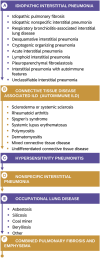Study Design and Rationale for the PHINDER Study: Pulmonary Hypertension Screening in Patients with Interstitial Lung Disease for Earlier Detection
- PMID: 40711711
- PMCID: PMC12373579
- DOI: 10.1007/s41030-025-00307-0
Study Design and Rationale for the PHINDER Study: Pulmonary Hypertension Screening in Patients with Interstitial Lung Disease for Earlier Detection
Abstract
Introduction: A common complication of interstitial lung disease (ILD) is pulmonary hypertension (PH), which is associated with increased morbidity and mortality and worsened quality of life. In ILD, evaluating for PH is recommended prior to lung transplantation. However, this is not standardized or routinely performed in earlier stages of ILD, and guidelines lack an evidence-based approach for PH screening in this population. Furthermore, right-heart catheterization (RHC) access can be limited in many settings. The objective of PHINDER (Pulmonary Hypertension Screening in Patients with Interstitial Lung Disease for Earlier Detection) is to prospectively develop screening strategies for PH in patients with ILD.
Methods: PHINDER is a prospective, non-interventional study that will enroll approximately 200 patients with ILD treated in a variety of settings in the United States (community centers, academic institutions, etc.). Patients must be diagnosed with ILD by high-resolution computed tomography (HRCT) and must not have a previously reported mean pulmonary arterial pressure (mPAP) > 20 mmHg. To enrich the population for PH, patients must meet additional criteria on Pulmonary Function Tests, HRCT, signs/symptoms, 6-min walk test, or echocardiography. Patients will undergo a variety of routine ILD clinical assessments. Lastly, patients receive a RHC to assess for PH, defined as mPAP > 20 mmHg with pulmonary arterial wedge pressure ≤ 15 mmHg and a pulmonary vascular resistance > 2 Wood Units. All treatment decisions are at the discretion of the provider and not influenced by study participation.
Planned outcomes: Following study completion, statistical tools will be used to derive a practical model for a screening algorithm using the variables identified in the study as most predictive of PH in patients with ILD.
Conclusions: Using a previously developed list of clinical assessments from PH and ILD experts, the PHINDER study aims to be the first prospectively enrolled study to evaluate prognostic screening strategies that can be used to develop an algorithm to predict the risk of PH in patients with ILD.
Trail registration: NCT05776225.
Keywords: Algorithm; Interstitial lung disease; Pulmonary hemodynamics; Pulmonary hypertension; Right heart catheterization; Risk score; Screening.
© 2025. The Author(s).
Conflict of interest statement
Declarations. Conflict of Interest: Tejaswini Kulkarni reports consultation fees from United Therapeutics and Aileron, speaker/ consultation fees from Boehringer Ingelheim Inc. and Veracyte, consultation/advisory board fees from Avalyn and PureTech Health. David Zisman is on the speaker’s bureau for, and received consultation fees from United Therapeutics Corp. Also, he declares he is partly funded by a generous gift from William and Jean Soman. Zisman was a previous author on the Delphi (Rahaghi, et al.) that was used to create the enrichment criteria for this study. David Kiely reports support from the Sheffield Biomedical Research Centre, consulting fees and other payments from Jansen Pharmaceuticals, Ferrer, Altavant, MSD and United Therapeutics. Oksana Shlobin reports consultancy fees from United Therapeutics, Merck, Janssen and Aerami, payment or honoraria for lectures, presentations, manuscript writing or educational events from Ferrera and United Therapeutics, participation on a data safety monitoring board or advisory board with Janssen, and leadership roles with ACCP/CHEST and World Symposium on Pulmonary Hypertension task force. Shlobin was a previous author on the Delphi (Rahaghi, et al.) that was used to create the enrichment criteria for this study. Maral DerSarkissian is an employee of Analysis Group, Inc. which received research funds for her participation in this study. Eric Shen, Kevin Maher, and Meredith Broderick are employees of United Therapeutics. Mary Beth Scholand reports consultation fees from Boehringer Ingelheim, Genentech, Veracyte, Imvaria, and United Therapeutics. Scholand was a previous author on the Delphi (Rahaghi, et al.) that was used to create the enrichment criteria for this study. Ethical Approval: This study protocol has been approved by the institutional review board at each participating site. This study was performed in accordance with the Helsinki Declaration of 1964, and its later amendments. All subjects provided informed consent to participate in the study. For this study, Advarra is the central IRB/main center, but some sites utilize local IRB in addition to or instead of Advarra (see supplementary material for details) and the study was approved by all institutions.
Figures


Similar articles
-
Prescription of Controlled Substances: Benefits and Risks.2025 Jul 6. In: StatPearls [Internet]. Treasure Island (FL): StatPearls Publishing; 2025 Jan–. 2025 Jul 6. In: StatPearls [Internet]. Treasure Island (FL): StatPearls Publishing; 2025 Jan–. PMID: 30726003 Free Books & Documents.
-
Cyclophosphamide for connective tissue disease-associated interstitial lung disease.Cochrane Database Syst Rev. 2018 Jan 3;1(1):CD010908. doi: 10.1002/14651858.CD010908.pub2. Cochrane Database Syst Rev. 2018. PMID: 29297205 Free PMC article.
-
Doppler trans-thoracic echocardiography for detection of pulmonary hypertension in adults.Cochrane Database Syst Rev. 2022 May 9;5(5):CD012809. doi: 10.1002/14651858.CD012809.pub2. Cochrane Database Syst Rev. 2022. PMID: 35532166 Free PMC article.
-
Exploring the potential of cardiopulmonary exercise testing (CPET) for tailored pulmonary rehabilitation in people with interstitial lung disease (ILD): A systematic review protocol.NIHR Open Res. 2025 Jul 4;4:51. doi: 10.3310/nihropenres.13706.2. eCollection 2024. NIHR Open Res. 2025. PMID: 40851771 Free PMC article.
-
MarkVCID cerebral small vessel consortium: I. Enrollment, clinical, fluid protocols.Alzheimers Dement. 2021 Apr;17(4):704-715. doi: 10.1002/alz.12215. Epub 2021 Jan 21. Alzheimers Dement. 2021. PMID: 33480172 Free PMC article.
References
-
- Seeger W, Adir Y, Barbera JA, et al. Pulmonary hypertension in chronic lung diseases. J Am Coll Cardiol. 2013;62(25 Suppl):D109–16. 10.1016/j.jacc.2013.10.036. - PubMed
-
- Travis WD, Costabel U, Hansell DM, et al. An official American Thoracic Society/European Respiratory Society statement: Update of the international multidisciplinary classification of the idiopathic interstitial pneumonias. Am J Respir Crit Care Med. 2013;188(6):733–48. 10.1164/rccm.201308-1483ST. - PMC - PubMed
Associated data
LinkOut - more resources
Full Text Sources
Medical

